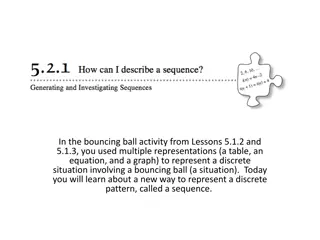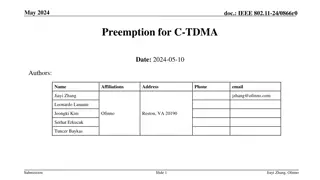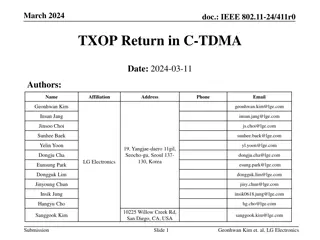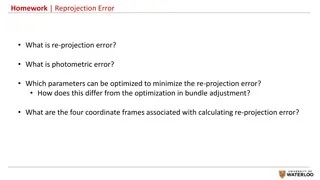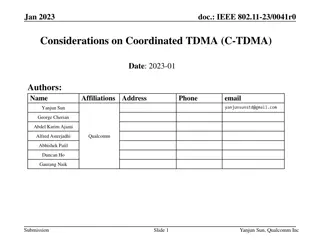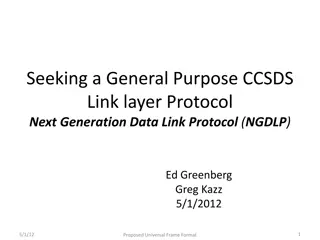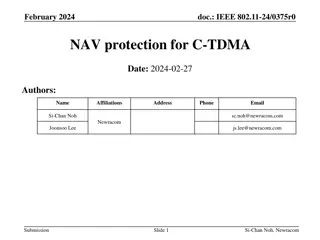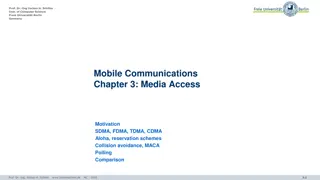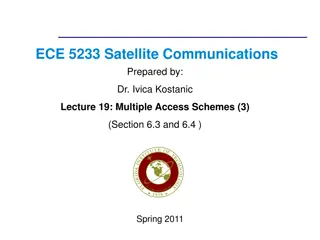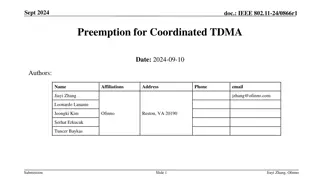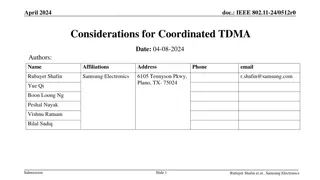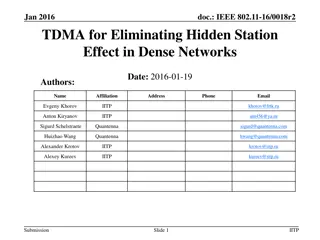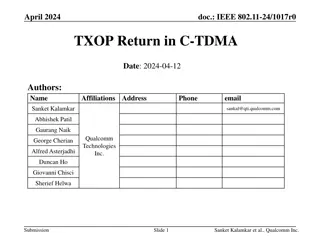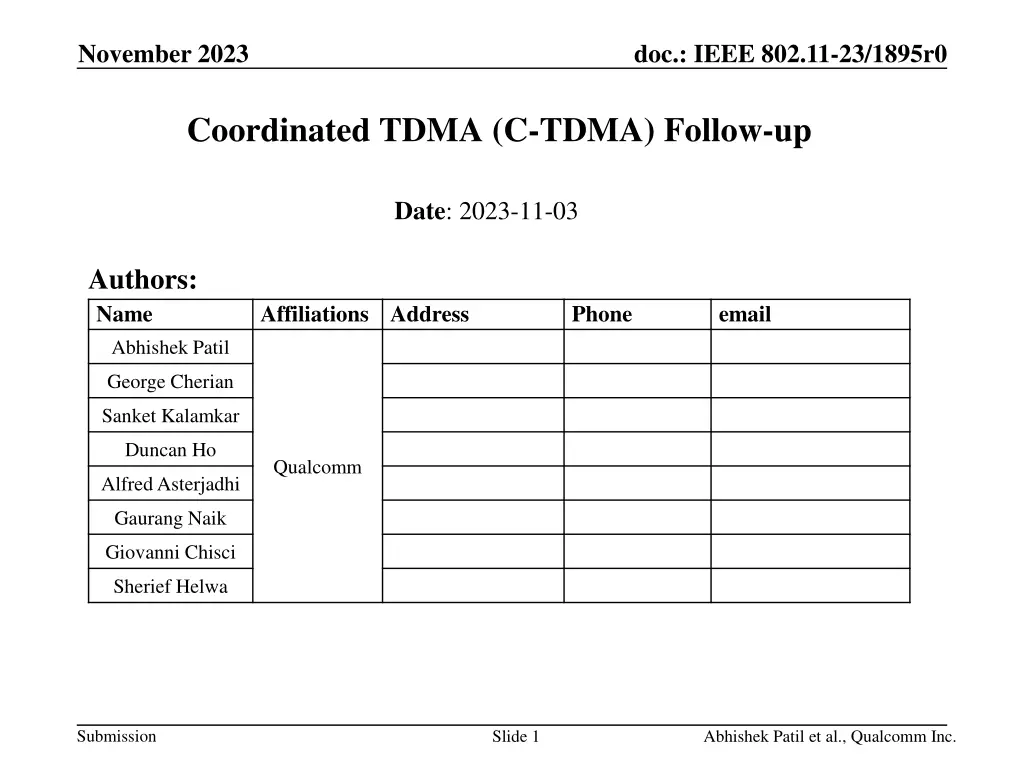
IEEE 802.11-23/1895r0 Coordinated TDMA (C-TDMA) Details
Explore the detailed framework of C-TDMA proposed in November 2023 for IEEE 802.11-23/1895r0. This contribution delves into frame exchange sequences, schedule announcements, TXOP sharing, and more to enhance medium access management in shared AP environments.
Download Presentation

Please find below an Image/Link to download the presentation.
The content on the website is provided AS IS for your information and personal use only. It may not be sold, licensed, or shared on other websites without obtaining consent from the author. If you encounter any issues during the download, it is possible that the publisher has removed the file from their server.
You are allowed to download the files provided on this website for personal or commercial use, subject to the condition that they are used lawfully. All files are the property of their respective owners.
The content on the website is provided AS IS for your information and personal use only. It may not be sold, licensed, or shared on other websites without obtaining consent from the author.
E N D
Presentation Transcript
November 2023 doc.: IEEE 802.11-23/1895r0 Coordinated TDMA (C-TDMA) Follow-up Date: 2023-11-03 Authors: Name Abhishek Patil Affiliations Address Phone email George Cherian Sanket Kalamkar Duncan Ho Qualcomm Alfred Asterjadhi Gaurang Naik Giovanni Chisci Sherief Helwa Submission Slide 1 Abhishek Patil et al., Qualcomm Inc.
November 2023 doc.: IEEE 802.11-23/1895r0 Introduction Background Previous contributions related to C-TDMA (see [1, 2, 3]) have: discussed how EHT s TXS framework can be extended for C-TDMA examined the need for a schedule allocation frame to provide an upfront notification to shared APs Other contributions have discussed NAV protection (see [3, 4]) This contribution provides the next level details for: Frame exchange sequences Based on EHT s TXS frame and the initial (schedule) announcement frame NAV protection Including TXOP return Submission Slide 2 Abhishek Patil et al., Qualcomm Inc.
November 2023 doc.: IEEE 802.11-23/1895r0 C-TDMA frame exchange sequence The sequence inherits the existing framework defined by 11ax and 11be Use MU-RTS (TXS) for schedule announcement and TXOP sharing. The initial Schedule Announcement frame identifies the AP(s) with whom the TXOP will be shared This helps manage the medium access between shared AP(s) so that they don t interference with each other [3] The upfront announcement also helps a shared AP(s) prepare i.e., helps account for any processing delay The frame also preps in-BSS STA(s) to be serviced by the AP. Submission Slide 3 Abhishek Patil et al., Qualcomm Inc.
November 2023 doc.: IEEE 802.11-23/1895r0 C-TDMA frame exchange sequence The schedule announcement frame: identifies the shared AP(s) and in-BSS STA(s) via the AID12 fields For example, shared AP(s) can be identified via the shared AP s BSS color and portion of the shared AP s BSSID [LBS of BSSID || 6 bit of BSS color] The partial BSSID helps in case of color collision In-BSS STA(s) identified based on their AID (same as baseline) In-BSS STA includes HE/EHT/UHR May be a TXS variant A field in the frame can provide the length of the TXOP Helps shared AP(s) determine how long to hold off (i.e., wait for shared TXOP from this AP). The TXOP allocation frame (MU-RTS TXS`): Extension of baseline TXS frame to provide information regarding: How long the TXOP is being shared with the AP identified in the frame. The traffic priority for sharing Other information TBD CF-END frame from shared AP returns the TXOP to the sharing AP Resets NAV for certain category of STAs (more details in the next slides) Submission Slide 4 Abhishek Patil et al., Qualcomm Inc.
November 2023 doc.: IEEE 802.11-23/1895r0 NAV Protection Design goals: Allow both downlink and trigger-based uplink transmissions From sharing and shared APs Allow legacy (i.e., HE/EHT) STAs to participate in the C-TDMA sequence Even during shared TXOP Allow unused portion of a shared TXOP to be returned to the sharing AP Sharing AP can use it to serve its own BSS or to further share it with another AP Avoid any exceptions to baseline rules to maintain legacy interop Submission Slide 5 Abhishek Patil et al., Qualcomm Inc.
Nov 2023 doc.: IEEE 802.11-23/1895r0 NAV Protection (single AP sharing) Submission Slide 6 Abhishek Patil, Qualcomm Inc.
November 2023 doc.: IEEE 802.11-23/1895r0 NAV Protection (single AP sharing) The schedule announcement frame from the TXOP owner AP (sharing AP) sets the NAV until the TXOP allocation frame that passes the TXOP to the shared AP Upon receiving the schedule announcement frame, the STAs in sharing AP s BSS will set their intra-BSS NAV; while STAs in all other BSSs will set their basic NAV The CTS responses help provide protection from STAs hidden to the sharing AP The TXOP allocation frame and the CTS (CTS2self) response sets the NAV for the duration of the shared TXOP Based on the RA/TA values of these frames, the intra-BSS NAV is set for STAs belonging to sharing AP & the shared AP and basic NAV is set for other BSSes It is likely that the duration of the shared TXOP is longer than the time the shared AP needs to serve its STA(s) The shared AP returns the TXOP via a CF-END frame. At this point, the sharing AP can utilize any residual time to serve in-BSS STAs This can be either DL (e.g., any LL flows that might have queued) or it could solicit triggered UL. The intra-BSS NAV continues to be set for sharing AP s BSS and transmissions in its BSS will set the basic NAV for everyone else s BSS. Submission Slide 7 Abhishek Patil et al., Qualcomm Inc.
November 2023 doc.: IEEE 802.11-23/1895r0 NAV Protection (multiple AP sharing) Slide 8 Submission Abhishek Patil et al., Qualcomm Inc.
November 2023 doc.: IEEE 802.11-23/1895r0 NAV Protection (multiple AP sharing) The schedule announcement step is the same as single AP sharing The TXOP allocation step is the same as single AP sharing With the additional requirement that other candidate AP(s) transmit a CTS with RA set to the shared AP to silence their in-BSS STAs that are hidden to sharing and shared AP s frames. A shared AP returns an unused portion of the (shared) TXOP via the CF- End frame and the sharing AP can utilize any residual time to serve in- BSS STAs (same as single AP sharing) After serving in-BSS STAs, the sharing AP can pass the TXOP to the next candidate AP (if any). Submission Slide 9 Abhishek Patil et al., Qualcomm Inc.
Nov 2023 doc.: IEEE 802.11-23/1895r0 Single vs multiple AP sharing Single AP sharing does not require deviation from baseline NAV behavior is same as baseline Today, an AP (sharing AP) sets the NAV for the duration it intents to serve its BSS Today, an AP (shared AP) can serve its STAs once the OBSS NAV is released The main difference (and benefit of CTDMA) is that shared AP gets access to the medium without having to contend. Key take-aways from multiple sharing: CTS response from other candidate AP(s) with RA set to shared AP Deviation from baseline Creates a large protection bubble (which can lead to over-suppression) STAs belonging to candidate AP(s) that receive the shared TXOP at later times are suppressed for a longer duration. With the above factors considered, propose to limit TXOP sharing to single AP. Submission Slide 10 Abhishek Patil, Qualcomm Inc.
November 2023 doc.: IEEE 802.11-23/1895r0 Summary In this contribution, we presented details of the C-TDMA frame exchange sequence. Which includes the scheduling frame for identifying the shared AP(s) upfront. Reuse existing MU-RTS (TXS) frame for initial schedule announcement and for sharing the TXOP Baseline CF-end to return a shared TXOP We also provide a NAV protection mechanism that Correctly sets the inter-BSS or basic NAV at various instances in the sequence for STAs belonging to different BSSes The proposed scheme will work for legacy as well as UHR STAs Enables HE/EHT STAs from participating during the shared TXOP The proposal recommends limiting TXOP sharing to single AP. Submission Slide 11 Abhishek Patil et al., Qualcomm Inc.
November 2023 doc.: IEEE 802.11-23/1895r0 SP #1 Do you agree that a TXOP owner AP shall announce its intention for sharing the TXOP in a Schedule Announcement* frame sent at the beginning of the TXOP and that the frame shall identify the AP(s) with whom it intends to share the TXOP? A TXOP owner AP that intents to share its TXOP is referred to as a sharing AP. The AP(s) identified in the Schedule Announcement frame are referred to as the shared AP(s). *Exact name is TBD Submission Slide 12 Abhishek Patil et al., Qualcomm Inc.
November 2023 doc.: IEEE 802.11-23/1895r0 SP #2 Do you agree that the Schedule Announcement frame shall be an MU-RTS Trigger frame? Submission Slide 13 Abhishek Patil et al., Qualcomm Inc.
November 2023 doc.: IEEE 802.11-23/1895r0 SP #3 Do you agree that a sharing AP shall send an individually addressed TXOP Allocation* frame to a shared AP to share its TXOP? *Exact name is TBD Submission Slide 14 Abhishek Patil et al., Qualcomm Inc.
November 2023 doc.: IEEE 802.11-23/1895r0 SP #4 Do you agree that the TXOP Allocation frame shall be an MU-RTS TXS Trigger frame? Submission Slide 15 Abhishek Patil et al., Qualcomm Inc.
November 2023 doc.: IEEE 802.11-23/1895r0 SP #5 Do you agree that a shared AP shall return the remainder of a shared TXOP to the sharing AP by transmitting a CF-End frame? Submission Slide 16 Abhishek Patil et al., Qualcomm Inc.
November 2023 doc.: IEEE 802.11-23/1895r0 SP #6 Do you agree that a sharing AP shall set the value of the Duration field of the TXOP Allocation frame to the shared TXOP duration that is allocated to the shared AP? The length of time shall be less than or equal to the pending TXOP time. Submission Slide 17 Abhishek Patil et al., Qualcomm Inc.
November 2023 doc.: IEEE 802.11-23/1895r0 References [1] Yanjun Sun and et al. (Qualcomm), Considerations on Coordinated TDMA (C-TDMA) , 23/0041r0, Jan 2023. [2] Dibakar Das and et al. (Qualcomm), C-TDMA procedure in UHR , 23/0261r0, Apr 2023. [3] Yanjun Sun and et al. (Qualcomm), Follow-up on Coordinated TDMA (C-TDMA) , 23/0739r1, Jul 2023. [4] Si-Chan Noh and et al. (Newracom), Considerations on Return TXOP between multiple APs , 23/1327r0, Aug 2023. [5] Liwen Chu and etc al. (NXP), Extended TXOP sharing , 23/249r1, May 2023. [6] George Cherian and et al. (Qualcomm), Coordinated AP Time/Frequency Sharing in a Transmit Opportunity in 11be , 19/1582r2, November 2019. Slide 18 Submission Abhishek Patil et al., Qualcomm Inc.


